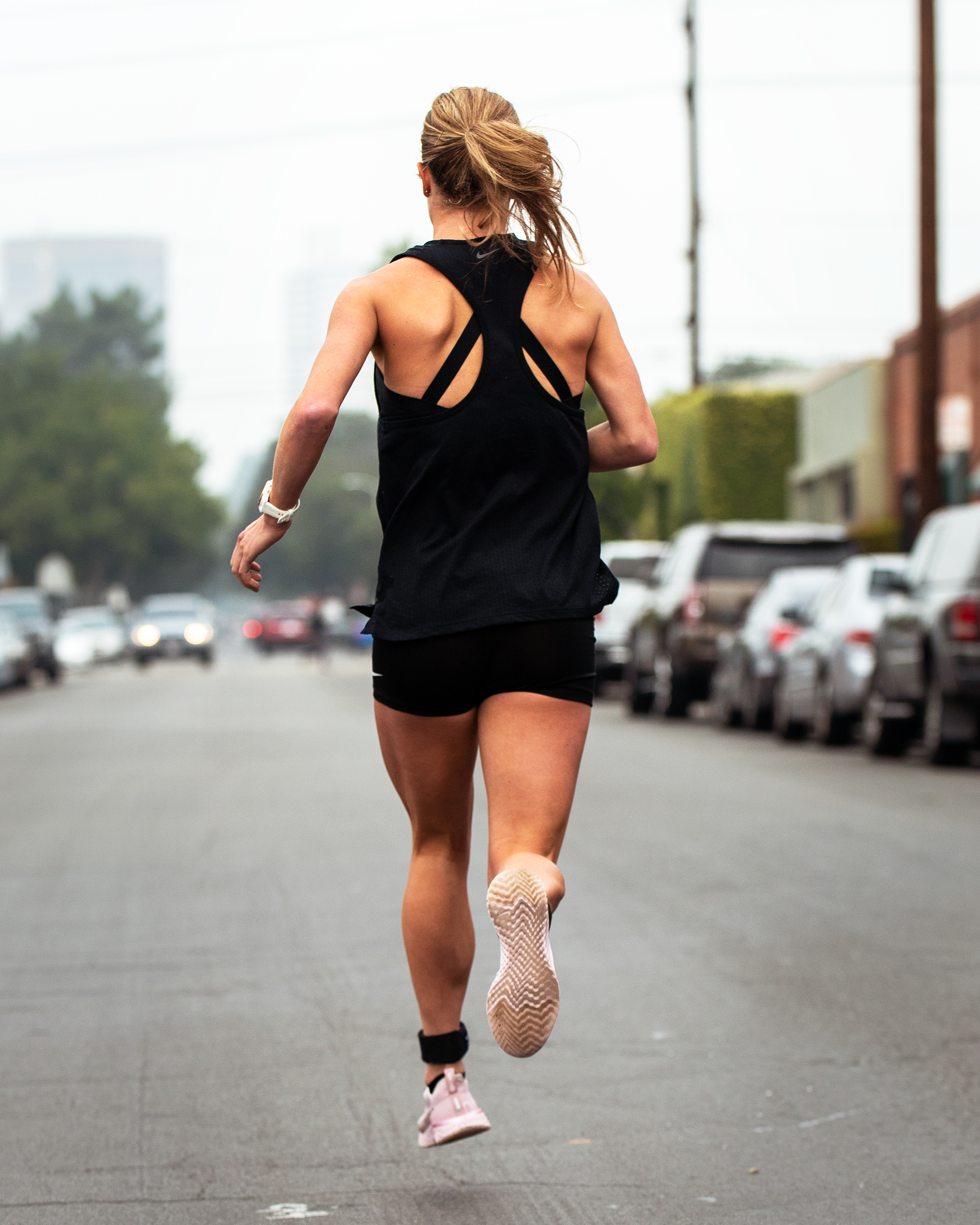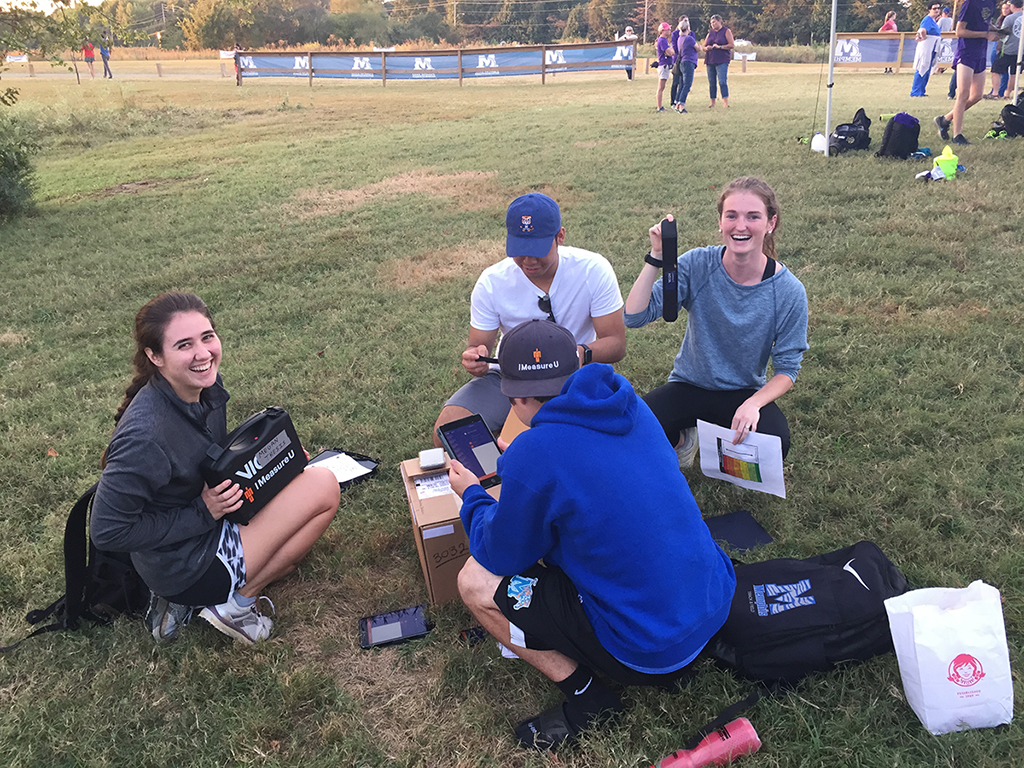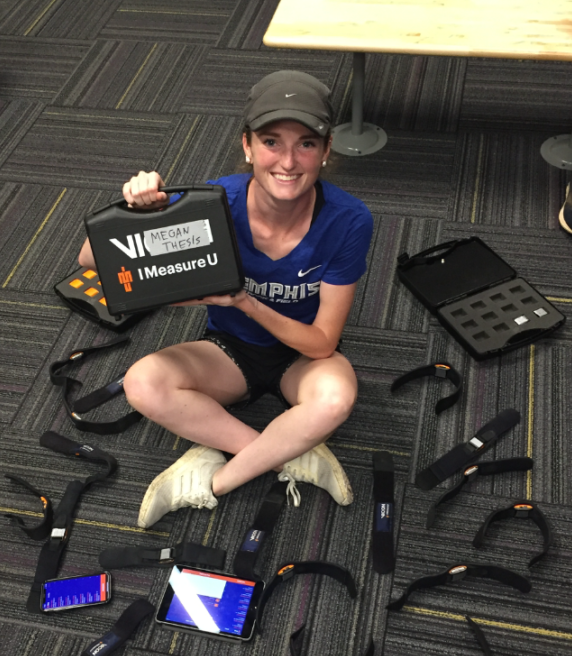“In North America, the term ‘weekly mileage’ is like the holy grail of distance running performance,” says Dr. Max Paquette. Max is an Associate Professor of Biomechanics in the Human Performance Center at the University of Memphis and is interested in quantifying training load in runners. “Everybody gauges performance, or how well an athlete is training based on how many miles they run per week. For some reason, there seems to be a mythical goal of 100 miles per week. Some coaches even believe that there are necessary mileage thresholds to achieve certain performances. ‘Mileage” is engrained in the running culture.”
Max and one of his Masters students, Megan Ryan, who is a competitive runner and was a member of the University of Memphis cross-country and track teams, have started to question whether there are key aspects of training that mileage alone is not telling the coaches and athletes. Training load monitoring using minutes instead of mileage has become increasingly popular. This is particularly prevalent in high schools where there are large numbers of athletes in training groups. “The human body does not come with an odometer or speedometer. It has no idea how far or how fast we run. It simply knows the extent to which its physiology is changed over the course of a run, which includes a time component.”
“The human body does not come with an odometer or speedometer, it has no idea how far or how fast we run. It simply knows the extent to which its physiology is changed over the course of a run.”

Wearable technology for runners
Until recently, even the most elite runners were only quantifying their training using duration and distance. The introduction of wearable technology has made more accurate tracking of not only mileage, but heart rate, elevation, cadence possible. However, many runners still rely on the most simple metrics to track their running training. In the world of sports performance, biomechanists are constantly looking for ways to increase performance while mitigating injury risks. This often involves the tracking of training to quantify the external loads applied to the body and the athlete responses.

“When you start thinking about it, it’s clear how only using mileage can muddy the waters to quantify a training response”
Alternative training load measures
Max goes on to explain: “When you start thinking about it, it’s clear how only using mileage can muddy the waters to quantify a training response. Here’s an example. Say a runner is assigned a 15km run on a Monday and a Thursday. However, on the Thursday, the runner is tired for a number of reasons (e.g., hard session Wednesday, poor sleep, etc.). The runner’s perceived exertion will dictate their pace and as a result, the time to complete the 15km distance. On the tired day (Thursday), a slower pace of 5min per km will result in a 75min run. Whereas on the non-tired day (Monday), a faster pace of 4min per km will result in a 60min run.
Here we have a scenario where a tired athlete spends 15min more running while tired to achieve the prescribed distance. Over time, these added minutes under tired conditions can add up in terms of unwanted training stress.”
Why not sRPE?
Even with sRPE, Max and Megan started to think that we could include more specific training load monitoring, potentially by combining internal and external measures. “Coaches in team sports and even in cycling have been quantifying training load using external and internal loads for years. There seems to be a lot of criticism in team sports when it comes to sRPE (session rating of perceived exertion). sRPE is an internal load metric in response to training.”
“This is because it is challenging to quantify effort between different training types (e.g., continuous, discontinuous, strength training). However, in running a lot of those complaints don’t exist because of the way we structure training. The focus of training is on continuous running with a lot less focus on skill or tactical training”.
‘How can we quantify training more accurately?’
Max and Megan began to speak to other local coaches who were working with runners. They found a common, question ‘how can we quantify training in a way that reflects the loads athletes are enduring in training more accurately?’ From years of collecting similar data, Max knew that as mileage changed, the overall training load in runners didn’t always follow that pattern. Sometimes it actually changes in opposite directions depending on daily perceived exertion. “Most coaches want to know how this week compared to last week and did that mirror what they had planned? Sometimes coaches may plan for X but in reality, the outcome is Y.”
This led Max and Megan to collaborate on a study with long-time local high school coach Nick Dwyer who leads a highly successful varsity boys cross country team. This investigation aimed to compare week-to-week changes among different training load measures. This was during periods when the coach had planned a ‘low training week’ followed by a ‘high training week’.
Training load differences across time
“We used a number of different training quantification methods including: weekly mileage, weekly minutes, sRPE x minutes, sRPE x “Bone Stimulus”, and sRPE x accumulated peak vertical force. IMeasureU Blue Thunder sensors collected Bone Stimulus, a proprietary metric from the IMeasureU IMU-Step software. Vertical in-shoe force data estimated the accumulated peak vertical force from Novel’s loadsol (wireless force insoles). This was in combination with daily run minutes and cadence.”
Unsurprisingly, Max and Megan saw that minutes went up from week 1 to week 2. This mirrored the prescribed increase in training minutes. The coach did not prescribe exact paces and distance, therefore mileage was more variable. When Megan and Max looked at the new training load metrics over the same time, things really got interesting.
“As a group, we saw all the different training load metrics increase from week 1 to week 2. However when we started to look at the individual runners and the variability in responses, things became interesting,” Max explains. “When comparing week 1 and week 2, the training loads of most boys increased while others’ decreased. This is where it gets exciting for us. When we added an internal (sRPE) to their training minutes to quantifying overall weekly training load, we observed different magnitudes or directions of week-to-week responses.”
Biomechanically specific metrics
Megan added: “We saw the sRPE x vertical force, and sRPE x minutes to be the most similar in terms of week-to-week magnitude changes and variability and they both had increases across the board with each athlete. We saw much lower inter-athlete variability with sRPE x Bone Stimulus than in the other two measures. sRPE x Bone Stimulus had one athlete who showed a decrease in training load between week 1 and week 2. This was when week 2 was intended to be a “high” training week.
“This shows that by using a more biomechanically specific external load metric, we can identify the individual response of the runner more accurately. Even though the week-to-week changes in training volume were consistent, the external load can be different.”

“Being able to present the running training load data to the coach and have him act on it immediately has allowed us to build a lot of trust between the data and the desired outcome which is ultimately athlete health and performance.”
Building trust with data
There were two individual cases that Max and Megan fed back to the coach immediately. They identified that these two athletes had much higher running training loads than the others in week 1, during a prescribed ‘easy’ week. Upon explaining this to the coach, this confirmed a hunch he had had that week. That led to him modifying their training as a precaution. Although the coach prescribed an easier week for week 1, the individual responded to the stimulus in an unanticipated way. This tells us that there is more to consider in training than just minutes or miles alone.
“Being able to present the data to the coach and have him act on it immediately has allowed us to build a lot of trust between the data and the desired outcome. This is ultimately athlete health and performance.”
To explore how objective training load monitoring can help in your own distance running environment, get in touch with us to speak with a sports scientist.
This case study builds on concepts we’ve explored in-depth at IMeasureU. Follow the links below to learn more –
Lower limb monitoring for drill categorization and rehab. A case study with the University of Memphis
Returning a world champion triathlete from a navicular fracture. A case study with Holly Lawrence
The best wearable technology for athletes. An industry overview
Have an injured athlete? Get in touch with us and ask about a free trial of IMU Step to see how we can help your return to play.




